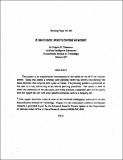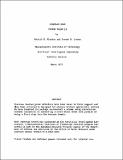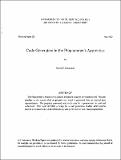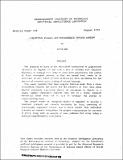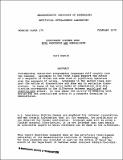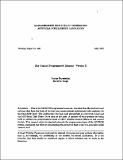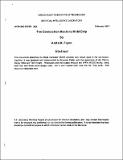Browsing AI Working Papers (1971 - 1995) by Title
Now showing items 23-42 of 291
-
Bargaining Between Goals
(MIT Artificial Intelligence Laboratory, 1975-01)Bargaining is a process used to modify conflicting demands on an expendable resource so that a satisfactory allocation can be made. In this paper, I consider the design of a bargaining system to handle the problem of ... -
The Binford-Horn LINEFINDER
(MIT Artificial Intelligence Laboratory, 1971-07)This paper briefly describes the processing performed in the course of producing a line drawing from vidisector information. -
A Birthday Party Frame System
(MIT Artificial Intelligence Laboratory, 1977-02)This paper is an experimental investigation of the utility of the MIT-AI frames system. Using this system, a birthday party planning system was written, representing the basic decisions that comprise such a plan as frames. ... -
BUILD -- A System Construction Tool
(MIT Artificial Intelligence Laboratory, 1984-08)BUILD is a proposed tool for constructing systems from existing modules. BUILD system descriptions are composed of module declarations and assertions of how modules refer to each other. An extensible library of information ... -
Building English Explanations from Function Descriptions
(MIT Artificial Intelligence Laboratory, 1979-04)An explanatory component is an important ingredient in any complex AI system. A simple generative scheme to build descriptive phrases from Lisp function calls can produce respectable explanations if explanation generators ... -
Capture It, Name It, Own it: How to capture re-occurring patterns, name them and turn them into reusable functions via Emacs kbd-macros
(MIT Artificial Intelligence Laboratory, 1992-05)The purpose of this talk is not to teach you about Emacs or Emacs kbd-macros, though we will use both as examples. I can teach you everything there is to know about Emacs and kbd-macros in 5 minutes. There are literally ... -
CGOL - an Alternative External Representation For LISP users
(MIT Artificial Intelligence Laboratory, 1976-03)Advantages of the standard external representation of LISP include its simple definition, its economical implementation and its convenient extensibility. These advantages have been gained by trading off syntactic variety ... -
Chapter and Verse Program Description
(MIT Artificial Intelligence Laboratory, 1984-06)The design of a program is rarely a straightforward mapping from the problem solution to the code. More frequently, fragments of high level concepts are distributed over one or more modules such that it is hard to identify ... -
Circular Scan
(MIT Artificial Intelligence Laboratory, 1972-03)Previous feature point detectors have been local in their support and have been universally designed for objects without appreciable texture. We have invented (or perhaps reinvented) a scheme using correlation between ... -
CL1 Manual
(MIT Artificial Intelligence Laboratory, 1983-09)CL1 is a prototyping language for programming a Connection Machine. It supports a model of the Connection Machine as a collection of tiny conventional machines (process elements), each with its own independent program counter. -
Climber: A Vertex-Finder
(MIT Artificial Intelligence Laboratory, 1973-02)A LISP program has been written which returns the location of a vertex in a suspected region, as well as an indication of the certainty of success. -
Code Generation in the Programmer's Apprentice
(MIT Artificial Intelligence Laboratory, 1982-05)The Programmer's Apprentice is a highly interactive program development tool. The user interface to the system relies on program text which is generated from an internal plan representation. The programs generated need to ... -
Cognitive Cliches
(MIT Artificial Intelligence Laboratory, 1986-04)This paper is an exploration of a wide class of mental structures called cognitive cliches that support intermediate methods that are moderately general purpose, in that a few of them will probably be applicable to any ... -
A Computational Theory of Animation
(MIT Artificial Intelligence Laboratory, 1977-04)A system is proposed capable of generating narrative computer animation in response to a simple script. The major problem addressed is how to imbed into the system some of the knowledge that animators use when creating ... -
Computer Detection of Bent Fingers in Lead Bonding Frames
(MIT Artificial Intelligence Laboratory, 1976-01)In the production of logic circuits in dual inline packages, various tedious assembly line tasks are performed by human operators using microscopes or television enlargements. One boring and difficult task is the detection ... -
Conceptual Phrases and Deterministic English Parsing
(MIT Artificial Intelligence Laboratory, 1979-08)The grammar of many of the lower-level constituents of grammatical structures in English has not been a area of exciting new linguistic discovery, in contrast with study of clause-level constituents. The syntax of these ... -
Concurrent Systems Need Both Sequences And Serializers
(MIT Artificial Intelligence Laboratory, 1979-02)Contemporary concurrent programming languages fall roughly into two classes. Languages in the first class support the notion of a sequence of values and some kind of pipelining operation over the sequence of values. Languages ... -
The Condor Programmer's Manual - Version II
(MIT Artificial Intelligence Laboratory, 1987-07)This is the CONDOR programmer's manual, that describes the hardware and software that form the basis of the real-time computational architecture built originally for the Utah-MIT hand. The architecture has been used ... -
The Connection Machine RAM Chip
(MIT Artificial Intelligence Laboratory, 1983-01-03)This document describes the three transistor NMOS dynamic ram circuit used in the connection machine. It was designed and implemented by Brewster Kahle, with the assistance of Jim Cherry, Danny Hillis and Tom Knight. ... -
CONS
(MIT Artificial Intelligence Laboratory, 1974-11)


